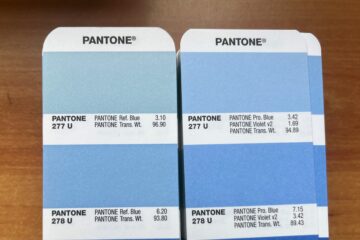From Dieline | By: Bill McCool on 09/09/2020 ||
“Hemp grows rapidly, maturing in as quickly as 90 days. Turning hemp into pulp requires fewer chemicals, water, and energy than wood.”
“Making paper with straw eliminates the need for ‘fall burns’ set by farmers to clear straw from their fields, creating acrid smoke and carbon emissions.”
“Recycled cotton paper is made from t-shirt and denim scraps, diverted from millions of tons of textile waste sent to landfills every year.”
These are the words that greet you as you flip through Mohawk’s latest swatchbook, a clear indication of where they’re headed with this new product.
Mohawk, the makers of premium, crafted papers for designers, brands, and printers, released a beautifully curated swatchbook that details the introduction of their latest line of sustainable offerings made from hemp, straw, and recycled cotton fiber: Mohawk Renewal. Mohawk chose to make these papers available because they come from annual crops that farmers can regrow within a year or even less.
This is all part of a concerted effort to get more sustainably-crafted papers into the world, because not only do consumers want more sustainable packaging, but according to a recent survey from Trivium Packaging, 74% of them would even go so far as to pay more for it.
But for Mohawk, there’s an even larger story at play, and when you look closer, you get an idea of how the packaging industry as a whole can move toward a better tomorrow.
Sustainability With a Story
Mohawk Renewal was born out of the many inquiries Mohawk was getting from designers, particularly with regards to cannabis and CBD brands that wanted to use hemp in their packaging. The papermaker was already a leader when it came to sustainable business practices—they source pulp from responsibly managed forests, utilize recycled fiber, and use wind power in their mills—but there was an opportunity to further improve and expand their offerings.
For them, this became the next chapter in that evolution to eco-friendly systems. Sure, they could develop packaging made from hemp, but that almost felt limiting, and they quickly focused on designers and what they need. For starters, these materials can amplify brand messaging, and in this way, the material itself becomes the megaphone, and that’s a POV you can communicate on your packaging. When you tell a consumer that the box you’re holding comes from hemp or recycled cotton, you’re telling your customers not only the story of your packaging but your brand’s ethos and commitment to the environment.
Of course, you can use hemp however you want when it comes to packaging, but consider what it means for a cannabis or CBD upstart. The box becomes a direct reflection of the material of the substance you’re buying on the inside.
Looking To The Past For A Better Tomorrow
Mohawk Renewal is also about reconnecting with what was already there to use. That way, designers can rediscover these methods of papermaking. Hemp, straw, and cotton rag are legacy materials, and, to shape our future and the world to come, Mohawk had to look to the past and some of the paper-making methods that have been with us all along.
- Hemp was very much a staple of the agricultural landscape of Colonial America and was used to make rope and, of course, paper. Commercial hemp had fallen out of favor because of controlled substance laws in the US, but now that those bans have been lifted, everyone wants to use this renewable material. A tree can take 7 to 35 years to mature, and once it’s gone, you’re going to need to plant more trees; with hemp, not so much, as your turnaround time can be as little as 90 days for harvesting.
- Straw isn’t just for stuffing scarecrows at Halloween or making hay bales, as it’s a byproduct of wheat farming. Typically, it gets disposed of or burned off by farmers and contributes to heightened greenhouse gases and the erosion of soil. But you can also mix it in with paper pulp as Mohawk has done here. Each of the papers uses 30% straw fiber and has the added benefit of utilizing 25% less water and 70% less energy during the production process. Additionally, it can get used to make tissue paper, molded products, and packaging.
- Can you use t-shirt and denim scraps to make paper? Absolutely. Recycled Cotton has been with us for centuries, and we’ve been recycling cotton textiles all that time. The problem is, we have even more of it because of fast fashion. However, you can divert these scraps from landfills so they won’t sit around trying to decompose for the next 200 years. The material itself is soft yet durable, and many countries use it for printing money.
Everyone wants a more sustainable future and to use materials that are better for the planet, giving consumers a clear conscience when it comes to where they choose to put their money. A lot of innovation in the sustainable and plastic-free packaging space often comes in the form of materials that are often impossible to scale for many global brands, but often the answer is right in front of us, and that’s clearly the case with hemp, straw, and recycled cotton. These methods of making paper just needed someone to champion them once again.
Responsible papermaking is the future, and designers and brands need to be an active participant in that future.
With the launch of Mohawk Renewal, Mohawk also introduced 50 count-small packs of envelopes and sheets to make sustainable paper easy to access. Interested in a pack? Use code DIELINE10 for 10% off your small pack order.
Want to learn more about Mohawk Renewal? Join Mohawk on September 16th at 2 PM EST for an in-depth look into this new offering. All attendees will receive exclusive access to new product promotions.Click here to register.
Go here to learn more about Mohawk Renewal!


